seats SKODA FABIA 2008 2.G / 5J Service Manual
[x] Cancel search | Manufacturer: SKODA, Model Year: 2008, Model line: FABIA, Model: SKODA FABIA 2008 2.G / 5JPages: 252, PDF Size: 40.88 MB
Page 136 of 252
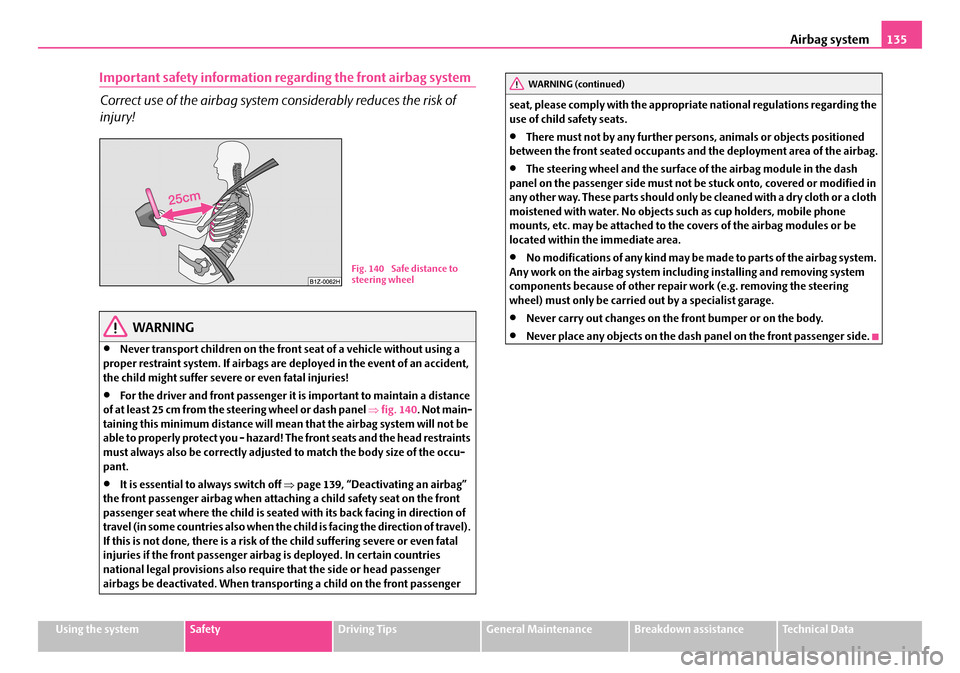
Airbag system135
Using the systemSafetyDriving TipsGeneral MaintenanceBreakdown assistanceTechnical Data
Important safety information regarding the front airbag system
Correct use of the airbag system considerably reduces the risk of
injury!
WARNING
•Never transport children on the front seat of a vehicle without using a proper restraint system. If airbags are deployed in the event of an accident, the child might suffer severe or even fatal injuries!
•For the driver and front passenger it is important to maintain a distance of at least 25 cm from the steering wheel or dash panel ⇒fig. 140. Not main-taining this minimum distance will mean that the airbag system will not be able to properly protect you - hazard! The front seats and the head restraints must always also be correctly adjusted to match the body size of the occu-pant.
•It is essential to always switch off ⇒page 139, “Deactivating an airbag” the front passenger airbag when attaching a child safety seat on the front passenger seat where the child is seated with its back facing in direction of travel (in some countries also when the child is facing the direction of travel). If this is not done, there is a risk of the child suffering severe or even fatal injuries if the front passenger airbag is deployed. In certain countries national legal provisions also require that the side or head passenger airbags be deactivated. When transporting a child on the front passenger
seat, please comply with the appropriate national regulations regarding the use of child safety seats.
•There must not by any further persons, animals or objects positioned between the front seated occupants and the deployment area of the airbag.
•The steering wheel and the surface of the airbag module in the dash panel on the passenger side must not be stuck onto, covered or modified in any other way. These parts should only be cleaned with a dry cloth or a cloth moistened with water. No objects such as cup holders, mobile phone mounts, etc. may be attached to the covers of the airbag modules or be located within the immediate area.
•No modifications of any kind may be made to parts of the airbag system. Any work on the airbag system including installing and removing system components because of other repair work (e.g. removing the steering wheel) must only be carried out by a specialist garage.
•Never carry out changes on the front bumper or on the body.
•Never place any objects on the dash panel on the front passenger side.
Fig. 140 Safe distance to steering wheel
WARNING (continued)
NKO A05F 20.book Page 135 Wednesday, April 2, 2008 1:02 PM
Page 137 of 252
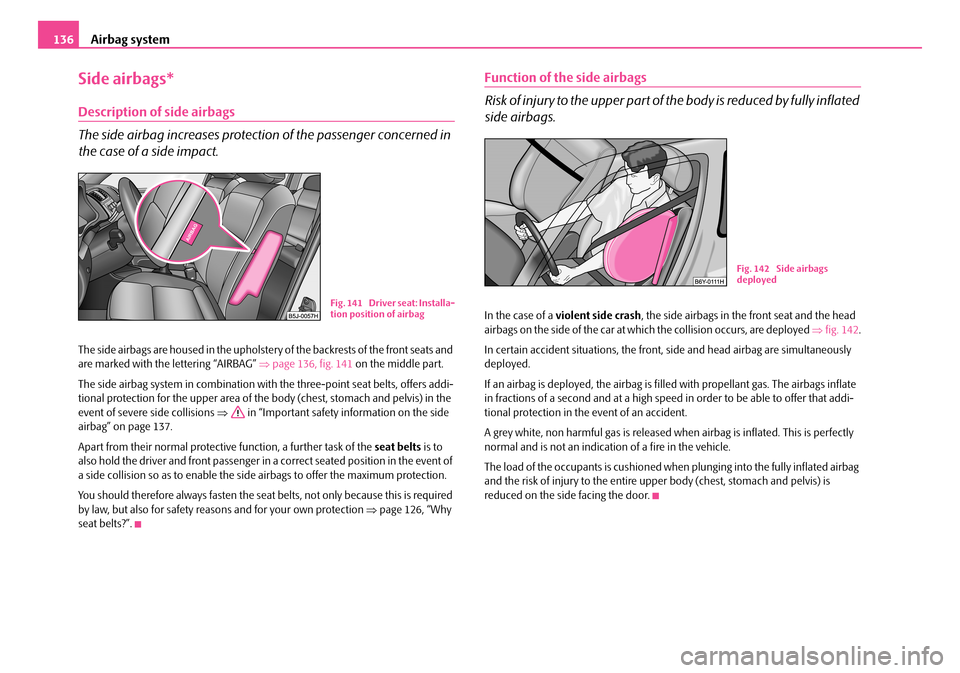
Airbag system136
Side airbags*
Description of side airbags
The side airbag increases protection of the passenger concerned in
the case of a side impact.
The side airbags are housed in the upholstery of the backrests of the front seats and are marked with the lettering “AIRBAG” ⇒page 136, fig. 141 on the middle part.
The side airbag system in combination with the three-point seat belts, offers addi-tional protection for the upper area of the body (chest, stomach and pelvis) in the event of severe side collisions ⇒ in “Important safety information on the side airbag” on page 137.
Apart from their normal protective function, a further task of the seat belts is to also hold the driver and front passenger in a correct seated position in the event of a side collision so as to enable the side airbags to offer the maximum protection.
You should therefore always fasten the seat belts, not only because this is required by law, but also for safety reasons and for your own protection ⇒page 126, “Why seat belts?”.
Function of the side airbags
Risk of injury to the upper part of the body is reduced by fully inflated
side airbags.
In the case of a violent side crash, the side airbags in the front seat and the head airbags on the side of the car at which the collision occurs, are deployed ⇒fig. 142.
In certain accident situations, the front, side and head airbag are simultaneously deployed.
If an airbag is deployed, the airbag is filled with propellant gas. The airbags inflate in fractions of a second and at a high speed in order to be able to offer that addi-tional protection in the event of an accident.
A grey white, non harmful gas is released when airbag is inflated. This is perfectly normal and is not an indication of a fire in the vehicle.
The load of the occupants is cushioned when plunging into the fully inflated airbag and the risk of injury to the entire upper body (chest, stomach and pelvis) is reduced on the side facing the door.
Fig. 141 Driver seat: Installa-tion position of airbag
Fig. 142 Side airbags deployed
NKO A05F 20.book Page 136 Wednesday, April 2, 2008 1:02 PM
Page 138 of 252
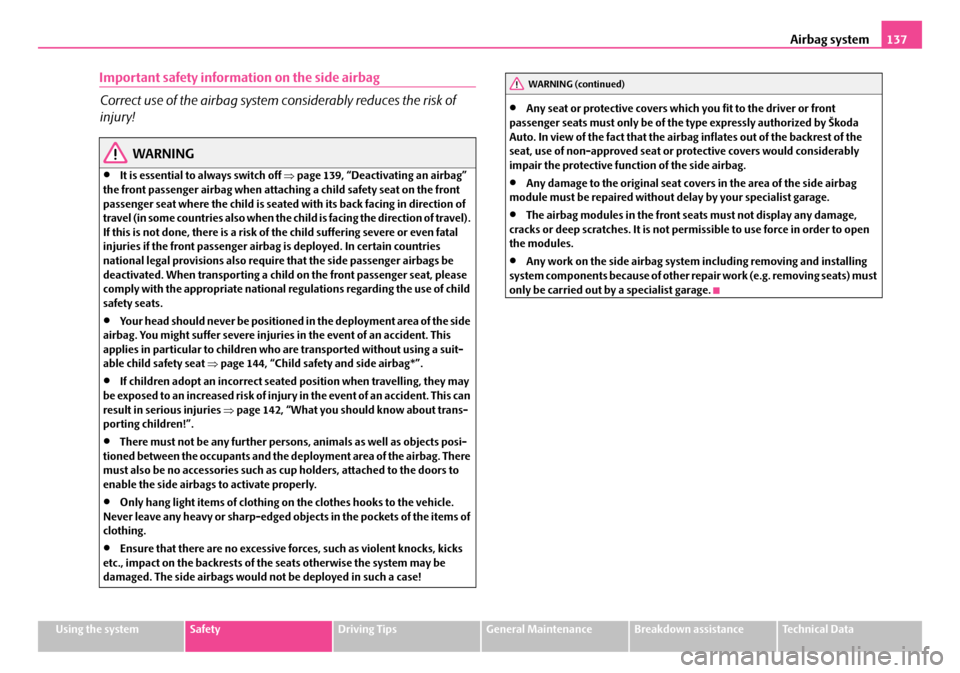
Airbag system137
Using the systemSafetyDriving TipsGeneral MaintenanceBreakdown assistanceTechnical Data
Important safety information on the side airbag
Correct use of the airbag system considerably reduces the risk of
injury!
WARNING
•It is essential to always switch off ⇒page 139, “Deactivating an airbag” the front passenger airbag when attaching a child safety seat on the front passenger seat where the child is seated with its back facing in direction of travel (in some countries also when the child is facing the direction of travel). If this is not done, there is a risk of the child suffering severe or even fatal injuries if the front passenger airbag is deployed. In certain countries national legal provisions also require that the side passenger airbags be deactivated. When transporting a child on the front passenger seat, please comply with the appropriate national regulations regarding the use of child safety seats.
•Your head should never be positioned in the deployment area of the side airbag. You might suffer severe injuries in the event of an accident. This applies in particular to children who are transported without using a suit-able child safety seat ⇒page 144, “Child safety and side airbag*”.
•If children adopt an incorrect seated position when travelling, they may be exposed to an increased risk of injury in the event of an accident. This can result in serious injuries ⇒page 142, “What you should know about trans-porting children!”.
•There must not be any further persons, animals as well as objects posi-tioned between the occupants and the deployment area of the airbag. There must also be no accessories such as cup holders, attached to the doors to enable the side airbags to activate properly.
•Only hang light items of clothing on the clothes hooks to the vehicle. Never leave any heavy or sharp-edged objects in the pockets of the items of clothing.
•Ensure that there are no excessive forces, such as violent knocks, kicks etc., impact on the backrests of the seats otherwise the system may be damaged. The side airbags would not be deployed in such a case!
•Any seat or protective covers which you fit to the driver or front passenger seats must only be of the type expressly authorized by Škoda Auto. In view of the fact that the airbag inflates out of the backrest of the seat, use of non-approved seat or protective covers would considerably impair the protective function of the side airbag.
•Any damage to the original seat covers in the area of the side airbag module must be repaired without delay by your specialist garage.
•The airbag modules in the front seats must not display any damage, cracks or deep scratches. It is not permissible to use force in order to open the modules.
•Any work on the side airbag system including removing and installing system components because of other repair work (e.g. removing seats) must only be carried out by a specialist garage.
WARNING (continued)
NKO A05F 20.book Page 137 Wednesday, April 2, 2008 1:02 PM
Page 140 of 252
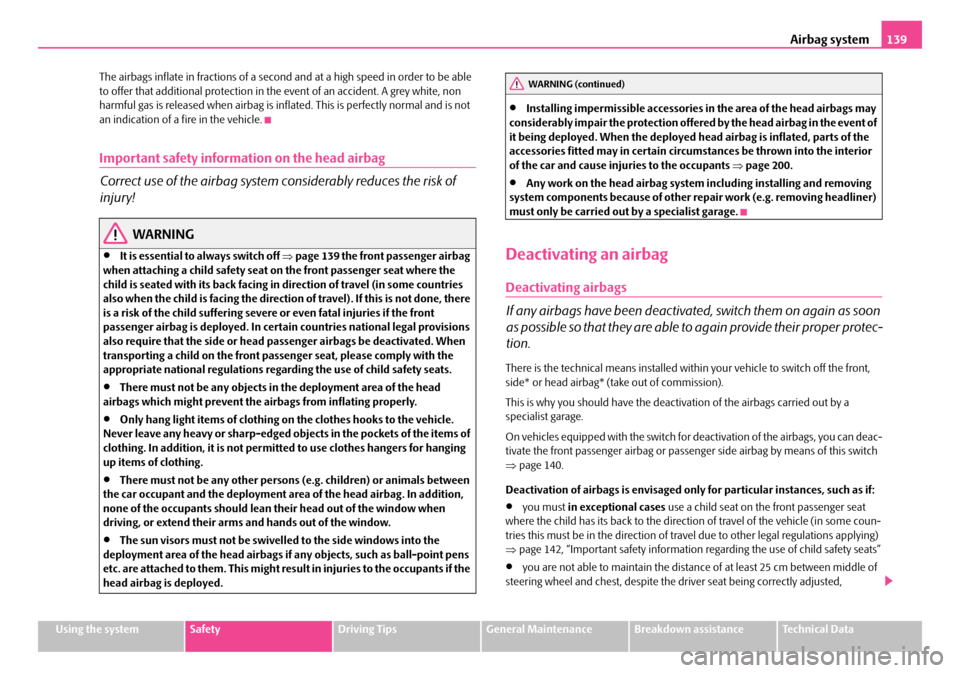
Airbag system139
Using the systemSafetyDriving TipsGeneral MaintenanceBreakdown assistanceTechnical Data
The airbags inflate in fractions of a second and at a high speed in order to be able to offer that additional protection in the event of an accident. A grey white, non harmful gas is released when airbag is inflated. This is perfectly normal and is not an indication of a fire in the vehicle.
Important safety information on the head airbag
Correct use of the airbag system considerably reduces the risk of
injury!
WARNING
•It is essential to always switch off ⇒page 139 the front passenger airbag when attaching a child safety seat on the front passenger seat where the child is seated with its back facing in direction of travel (in some countries also when the child is facing the direction of travel). If this is not done, there is a risk of the child suffering severe or even fatal injuries if the front passenger airbag is deployed. In certain countries national legal provisions also require that the side or head passenger airbags be deactivated. When transporting a child on the front passenger seat, please comply with the appropriate national regulations regarding the use of child safety seats.
•There must not be any objects in the deployment area of the head airbags which might prevent the airbags from inflating properly.
•Only hang light items of clothing on the clothes hooks to the vehicle. Never leave any heavy or sharp-edged objects in the pockets of the items of clothing. In addition, it is not permitted to use clothes hangers for hanging up items of clothing.
•There must not be any other persons (e.g. children) or animals between the car occupant and the deployment area of the head airbag. In addition, none of the occupants should lean their head out of the window when driving, or extend their arms and hands out of the window.
•The sun visors must not be swivelled to the side windows into the deployment area of the head airbags if any objects, such as ball-point pens etc. are attached to them. This might result in injuries to the occupants if the head airbag is deployed.
•Installing impermissible accessories in the area of the head airbags may considerably impair the protection offered by the head airbag in the event of it being deployed. When the deployed head airbag is inflated, parts of the accessories fitted may in certain circumstances be thrown into the interior of the car and cause injuries to the occupants ⇒page 200.
•Any work on the head airbag system including installing and removing system components because of other repair work (e.g. removing headliner) must only be carried out by a specialist garage.
Deactivating an airbag
Deactivating airbags
If any airbags have been deactivated, switch them on again as soon
as possible so that they are able to again provide their proper protec-
tion.
There is the technical means installed within your vehicle to switch off the front, side* or head airbag* (take out of commission).
This is why you should have the deactivation of the airbags carried out by a specialist garage.
On vehicles equipped with the switch for deactivation of the airbags, you can deac-tivate the front passenger airbag or passenger side airbag by means of this switch ⇒page 140.
Deactivation of airbags is envisaged only for particular instances, such as if:
•you must in exceptional cases use a child seat on the front passenger seat where the child has its back to the direction of travel of the vehicle (in some coun-tries this must be in the direction of travel due to other legal regulations applying) ⇒page 142, “Important safety information regarding the use of child safety seats”
•you are not able to maintain the distance of at least 25 cm between middle of steering wheel and chest, despite the driver seat being correctly adjusted,
WARNING (continued)
NKO A05F 20.book Page 139 Wednesday, April 2, 2008 1:02 PM
Page 141 of 252
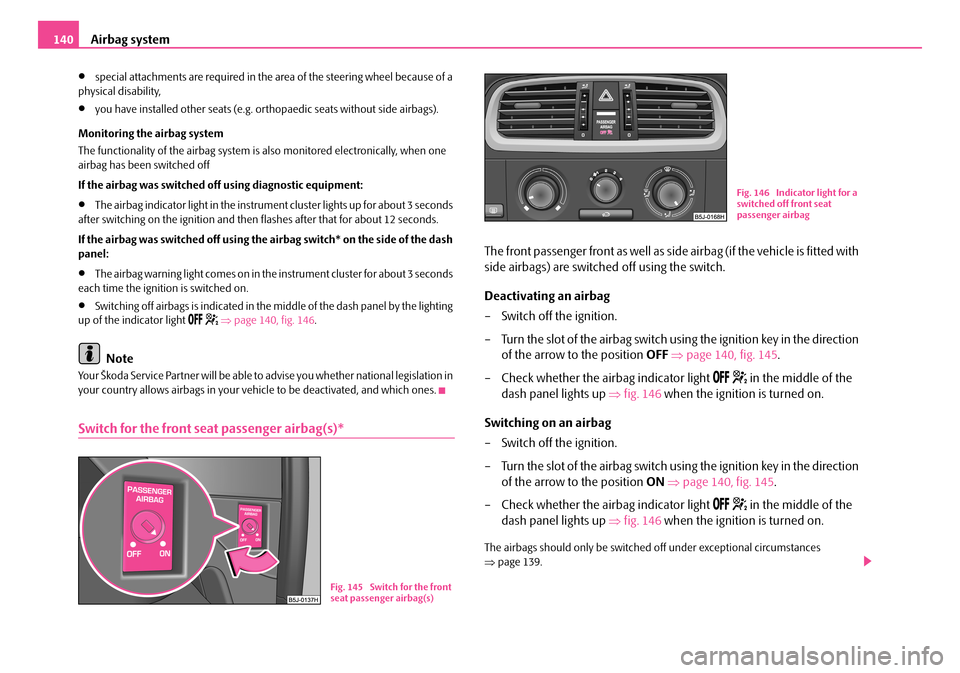
Airbag system140
•special attachments are required in the area of the steering wheel because of a physical disability,
•you have installed other seats (e.g. orthopaedic seats without side airbags).
Monitoring the airbag system
The functionality of the airbag system is also monitored electronically, when one airbag has been switched off
If the airbag was switched off using diagnostic equipment:
•The airbag indicator light in the instrument cluster lights up for about 3 seconds after switching on the ignition and then flashes after that for about 12 seconds.
If the airbag was switched off using the airbag switch* on the side of the dash panel:
•The airbag warning light comes on in the instrument cluster for about 3 seconds each time the ignition is switched on.
•Switching off airbags is indicated in the middle of the dash panel by the lighting up of the indicator light ⇒page 140, fig. 146.
Note
Your Škoda Service Partner will be able to advise you whether national legislation in your country allows airbags in your vehicle to be deactivated, and which ones.
Switch for the front seat passenger airbag(s)*
The front passenger front as well as side airbag (if the vehicle is fitted with
side airbags) are switched off using the switch.
Deactivating an airbag
– Switch off the ignition.
– Turn the slot of the airbag switch using the ignition key in the direction
of the arrow to the position OFF ⇒page 140, fig. 145.
– Check whether the airbag indicator light in the middle of the
dash panel lights up ⇒fig. 146 when the ignition is turned on.
Switching on an airbag
– Switch off the ignition.
– Turn the slot of the airbag switch using the ignition key in the direction
of the arrow to the position ON ⇒page 140, fig. 145.
– Check whether the airbag indicator light in the middle of the
dash panel lights up ⇒fig. 146 when the ignition is turned on.
The airbags should only be switched off under exceptional circumstances ⇒page 139.
Fig. 145 Switch for the front seat passenger airbag(s)
Fig. 146 Indicator light for a switched off front seat passenger airbag
NKO A05F 20.book Page 140 Wednesday, April 2, 2008 1:02 PM
Page 143 of 252
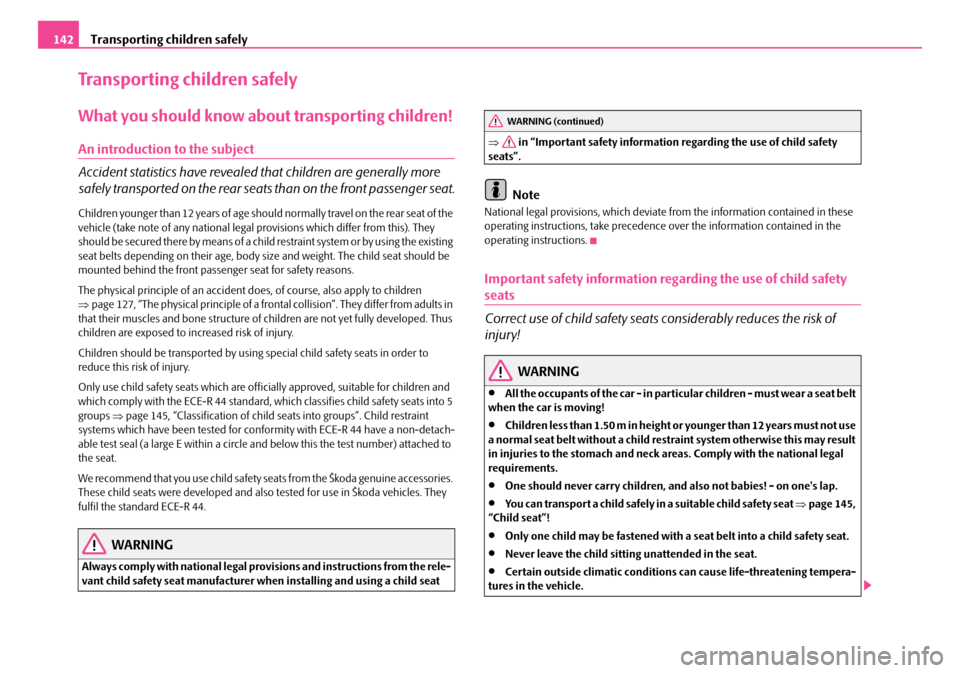
Transporting children safely142
Transporting children safely
What you should know about transporting children!
An introduction to the subject
Accident statistics have revealed that children are generally more
safely transported on the rear seats than on the front passenger seat.
Children younger than 12 years of age should normally travel on the rear seat of the vehicle (take note of any national legal provisions which differ from this). They should be secured there by means of a child restraint system or by using the existing seat belts depending on their age, body size and weight. The child seat should be mounted behind the front passenger seat for safety reasons.
The physical principle of an accident does, of course, also apply to children ⇒page 127, “The physical principle of a frontal collision”. They differ from adults in that their muscles and bone structure of children are not yet fully developed. Thus children are exposed to increased risk of injury.
Children should be transported by using special child safety seats in order to reduce this risk of injury.
Only use child safety seats which are officially approved, suitable for children and which comply with the ECE-R 44 standard, which classifies child safety seats into 5 groups ⇒page 145, “Classification of child seats into groups”. Child restraint systems which have been tested for conformity with ECE-R 44 have a non-detach-able test seal (a large E within a circle and below this the test number) attached to the seat.
We recommend that you use child safety seats from the Škoda genuine accessories. These child seats were developed and also tested for use in Škoda vehicles. They fulfil the standard ECE-R 44.
WARNING
Always comply with national legal provisions and instructions from the rele-vant child safety seat manufacturer when installing and using a child seat
⇒ in “Important safety information regarding the use of child safety seats”.
Note
National legal provisions, which deviate from the information contained in these operating instructions, take precedence over the information contained in the operating instructions.
Important safety information regarding the use of child safety
seats
Correct use of child safety seats considerably reduces the risk of
injury!
WARNING
•All the occupants of the car - in particular children - must wear a seat belt when the car is moving!
•Children less than 1.50 m in height or younger than 12 years must not use a normal seat belt without a child restraint system otherwise this may result in injuries to the stomach and neck areas. Comply with the national legal requirements.
•One should never carry children, and also not babies! - on one's lap.
•You can transport a child safely in a suitable child safety seat ⇒page 145, “Child seat”!
•Only one child may be fastened with a seat belt into a child safety seat.
•Never leave the child sitting unattended in the seat.
•Certain outside climatic conditions can cause life-threatening tempera-tures in the vehicle.
WARNING (continued)
NKO A05F 20.book Page 142 Wednesday, April 2, 2008 1:02 PM
Page 144 of 252

Transporting children safely143
Using the systemSafetyDriving TipsGeneral MaintenanceBreakdown assistanceTechnical Data
•Never allow your child to be transported in a vehicle without the use of a suitable restraint system.
•Children should also never stand up in a vehicle or kneel on the seats when the vehicle is moving. In the event of an accident the child will be thrown through the vehicle and may as a result suffer fatal injuries, and also injure other occupants.
•Children are exposed to an increased risk of injury in the event of an acci-dent if they lean forward or adopt an incorrect seated position when the vehicle is moving. This particularly applies to children who are transported on the front passenger seat if the airbag system deploys in the event of an accident. This can result in severe or even fatal injuries.
•It is important that the belt webbing is properly routed if the seat belts are to offer their maximum protection ⇒page 128, “How are seat belts correctly fastened?”. Pay particular attention to the information provided by the manufacturer of the child safety seat regarding correct routing of the belt. Seat belts which are not correctly adjusted can themselves cause inju-ries even in minor accidents.
•Safety belts must be checked to ensure that they are running properly. One should also ensure that the belt is not damaged by sharp-edged fittings.
•It is essential to always switch off ⇒page 139 the front passenger airbag when attaching a child safety seat on the front passenger seat where the child is seated with its back facing in direction of travel (in some countries also when the child is facing the direction of travel). If this is not done, there is a risk of the child suffering severe or even fatal injuries if the front passenger airbag is deployed. In certain countries national legal provisions also require that the side or head passenger airbags be deactivated. When transporting a child on the front passenger seat, please comply with the appropriate national regulations regarding the use of child safety seats.
Use of child safety seats on the front passenger seat
Child safety seats should always be attached to the rear seats.
We recommend, for safety reasons, that you always mount a child restraint systems on the rear seats whenever possible. If you still decide, however, to use a child safety seat on the front passenger seat then you must pay attention to the following warnings in connection with the use of the airbag system on the front passenger seat.
WARNING
•Warning - particular hazard! Never use a child safety seat on the front passenger seat in which the child is seated with its back facing the direction of travel. This child safety seat is positioned in the deployment area of the front passenger airbag. The airbag may cause the child severe, or even fatal injuries, in the event of it being deployed.
•This is also clearly stated on the sticker which is located on the centre column of the body on the front passenger side ⇒fig. 147. The sticker is visible upon opening the front passenger door. For some countries, the sticker is also affixed to the sun visor of the front passenger.
•It is essential to always switch off ⇒page 139, “Deactivating an airbag” the front passenger airbag when attaching a child safety seat on the front passenger seat where the child is seated with its back facing in direction of travel (in some countries also when the child is facing the direction of travel).
WARNING (continued)
Fig. 147 Sticker on the centre column of the body on the front passenger side.
NKO A05F 20.book Page 143 Wednesday, April 2, 2008 1:02 PM
Page 145 of 252
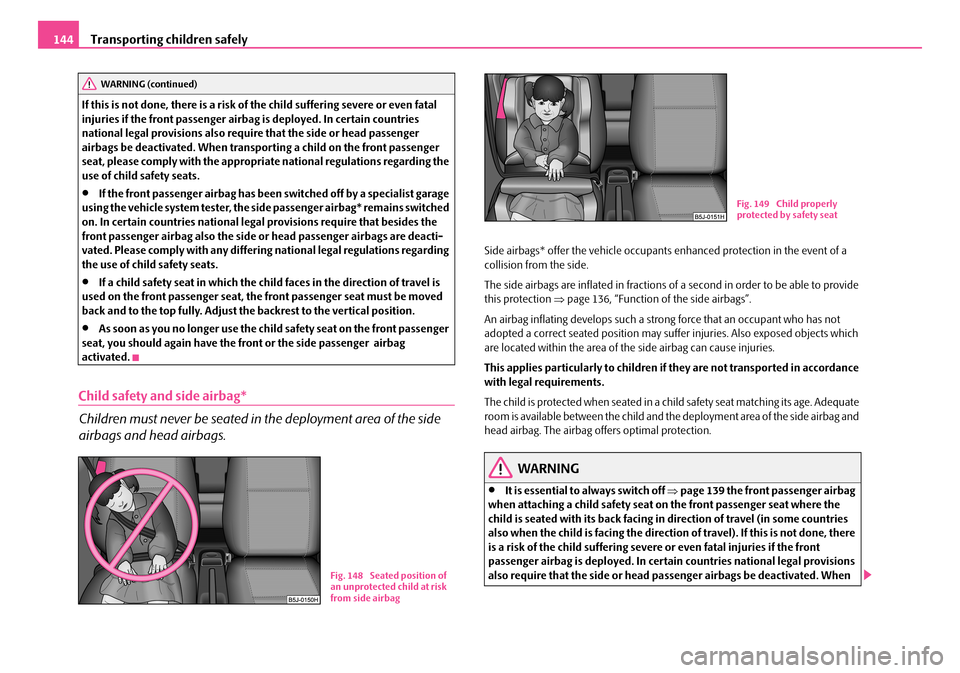
Transporting children safely144
If this is not done, there is a risk of the child suffering severe or even fatal injuries if the front passenger airbag is deployed. In certain countries national legal provisions also require that the side or head passenger airbags be deactivated. When transporting a child on the front passenger seat, please comply with the appropriate national regulations regarding the use of child safety seats.
•If the front passenger airbag has been switched off by a specialist garage using the vehicle system tester, the side passenger airbag* remains switched on. In certain countries national legal provisions require that besides the front passenger airbag also the side or head passenger airbags are deacti-vated. Please comply with any differing national legal regulations regarding the use of child safety seats.
•If a child safety seat in which the child faces in the direction of travel is used on the front passenger seat, the front passenger seat must be moved back and to the top fully. Adjust the backrest to the vertical position.
•As soon as you no longer use the child safety seat on the front passenger seat, you should again have the front or the side passenger airbag activated.
Child safety and side airbag*
Children must never be seated in the deployment area of the side
airbags and head airbags.
Side airbags* offer the vehicle occupants enhanced protection in the event of a collision from the side.
The side airbags are inflated in fractions of a second in order to be able to provide this protection ⇒page 136, “Function of the side airbags”.
An airbag inflating develops such a strong force that an occupant who has not adopted a correct seated position may suffer injuries. Also exposed objects which are located within the area of the side airbag can cause injuries.
This applies particularly to children if they are not transported in accordance with legal requirements.
The child is protected when seated in a child safety seat matching its age. Adequate room is available between the child and the deployment area of the side airbag and head airbag. The airbag offers optimal protection.
WARNING
•It is essential to always switch off ⇒page 139 the front passenger airbag when attaching a child safety seat on the front passenger seat where the child is seated with its back facing in direction of travel (in some countries also when the child is facing the direction of travel). If this is not done, there is a risk of the child suffering severe or even fatal injuries if the front passenger airbag is deployed. In certain countries national legal provisions also require that the side or head passenger airbags be deactivated. When
WARNING (continued)
Fig. 148 Seated position of an unprotected child at risk from side airbag
Fig. 149 Child properly protected by safety seat
NKO A05F 20.book Page 144 Wednesday, April 2, 2008 1:02 PM
Page 146 of 252

Transporting children safely145
Using the systemSafetyDriving TipsGeneral MaintenanceBreakdown assistanceTechnical Data
transporting a child on the front passenger seat, please comply with the appropriate national regulations regarding the use of child safety seats.
•When transporting a child on the front passenger seat, please comply with the appropriate national regulations regarding the use of child safety seats.
•Children must never be seated with their head in the deployment area of the side airbag - risk of injury!
•Do not place any objects within the deployment area of the side airbag - risk of injury!
Child seat
Classification of child seats into groups
Only child safety seats which have an official approval and are suit-
able for the child, may be used.
ECE-R 44 standard applies to child safety seats. ECE-R means: Economic Commis-sion of Europe - Regulation.
Child safety seats which have been tested for conformity with ECE-R 44 have a non-detachable test seal (a large E within a circle and below this the test number) attached to the seat.
Child safety seats are classified in 5 groups:
Children of more than 150 cm in height may use the seat belts fitted to the vehicle without a seat bolster.
Use of child seats
An overview of the usefulness of child seats on each of the seats according to the EG guidelines 77/541 and ECE 44 standard:
Universal category - seat is suitable for all approved types of child safety seats.
The seat can be fitted with fixing eyes for the “ISOFIX*”system.
The seat is equipped as standard with the fixing system “To p Te t h e r”.
Child seats of group 0/0+
GroupWeight
00 - 10 kg⇒page 145
0+up to 13 kg⇒page 145
19 - 18 kg⇒page 146
215 - 25 kg⇒page 147
322 - 36 kg⇒page 147
WARNING (continued)
Child seat groupsFront passenger seatRear seat outsideRear seat middle
0
0+
1
2 and 3
AUAUA+ATAU
AUAUA+ATAU
AUAUA+ATAU
AUAUAU
AU
A+
AT
Fig. 150 Child seats of group 0/0+
NKO A05F 20.book Page 145 Wednesday, April 2, 2008 1:02 PM
Page 147 of 252
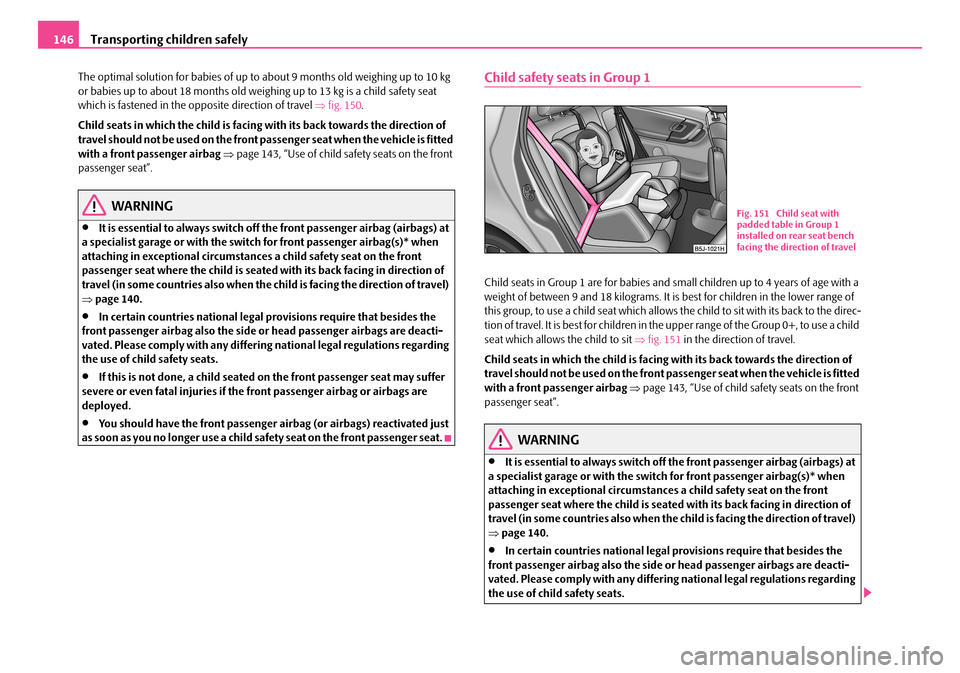
Transporting children safely146
The optimal solution for babies of up to about 9 months old weighing up to 10 kg or babies up to about 18 months old weighing up to 13 kg is a child safety seat which is fastened in the opposite direction of travel ⇒fig. 150.
Child seats in which the child is facing with its back towards the direction of travel should not be used on the front passenger seat when the vehicle is fitted with a front passenger airbag ⇒page 143, “Use of child safety seats on the front passenger seat”.
WARNING
•It is essential to always switch off the front passenger airbag (airbags) at a specialist garage or with the switch for front passenger airbag(s)* when attaching in exceptional circumstances a child safety seat on the front passenger seat where the child is seated with its back facing in direction of travel (in some countries also when the child is facing the direction of travel) ⇒page 140.
•In certain countries national legal provisions require that besides the front passenger airbag also the side or head passenger airbags are deacti-vated. Please comply with any differing national legal regulations regarding the use of child safety seats.
•If this is not done, a child seated on the front passenger seat may suffer severe or even fatal injuries if the front passenger airbag or airbags are deployed.
•You should have the front passenger airbag (or airbags) reactivated just as soon as you no longer use a child safety seat on the front passenger seat.
Child safety seats in Group 1
Child seats in Group 1 are for babies and small children up to 4 years of age with a weight of between 9 and 18 kilograms. It is best for children in the lower range of this group, to use a child seat which allows the child to sit with its back to the direc-tion of travel. It is best for children in the upper range of the Group 0+, to use a child seat which allows the child to sit ⇒fig. 151 in the direction of travel.
Child seats in which the child is facing with its back towards the direction of travel should not be used on the front passenger seat when the vehicle is fitted with a front passenger airbag ⇒page 143, “Use of child safety seats on the front passenger seat”.
WARNING
•It is essential to always switch off the front passenger airbag (airbags) at a specialist garage or with the switch for front passenger airbag(s)* when attaching in exceptional circumstances a child safety seat on the front passenger seat where the child is seated with its back facing in direction of travel (in some countries also when the child is facing the direction of travel) ⇒page 140.
•In certain countries national legal provisions require that besides the front passenger airbag also the side or head passenger airbags are deacti-vated. Please comply with any differing national legal regulations regarding the use of child safety seats.
Fig. 151 Child seat with padded table in Group 1 installed on rear seat bench facing the direction of travel
NKO A05F 20.book Page 146 Wednesday, April 2, 2008 1:02 PM